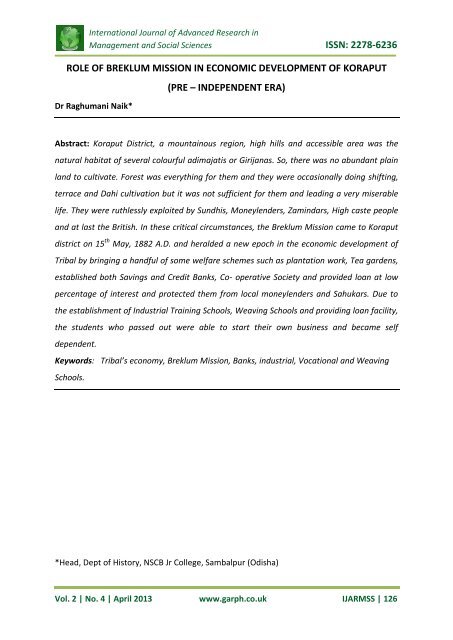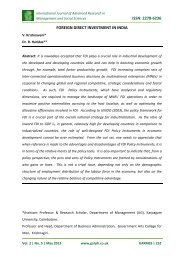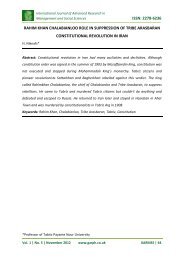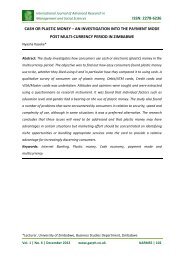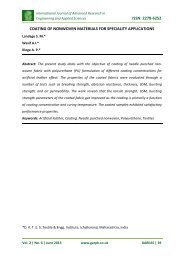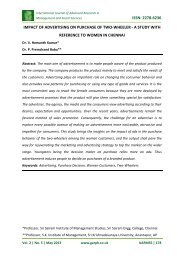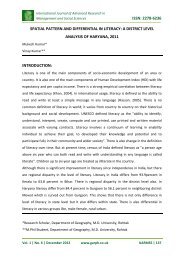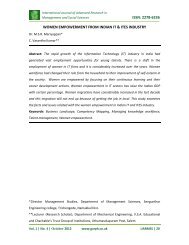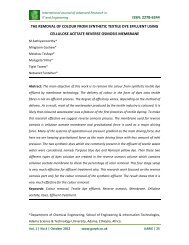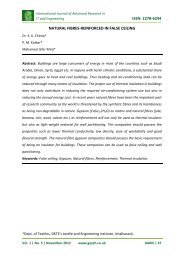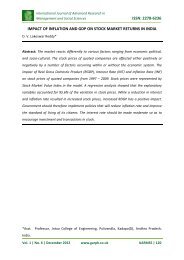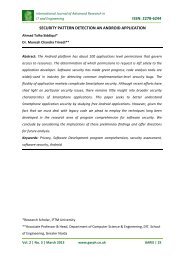issn: 2278-6236 role of breklum mission in economic ... - Garph.co.uk
issn: 2278-6236 role of breklum mission in economic ... - Garph.co.uk
issn: 2278-6236 role of breklum mission in economic ... - Garph.co.uk
Create successful ePaper yourself
Turn your PDF publications into a flip-book with our unique Google optimized e-Paper software.
International Journal <strong>of</strong> Advanced Research <strong>in</strong><br />
Management and Social Sciences ISSN: <strong>2278</strong>-<strong>6236</strong><br />
ROLE OF BREKLUM MISSION IN ECONOMIC DEVELOPMENT OF KORAPUT<br />
Dr Raghumani Naik*<br />
(PRE – INDEPENDENT ERA)<br />
Abstract: Koraput District, a mounta<strong>in</strong>ous region, high hills and accessible area was the<br />
natural habitat <strong>of</strong> several <strong>co</strong>lourful adimajatis or Girijanas. So, there was no abundant pla<strong>in</strong><br />
land to cultivate. Forest was everyth<strong>in</strong>g for them and they were occasionally do<strong>in</strong>g shift<strong>in</strong>g,<br />
terrace and Dahi cultivation but it was not sufficient for them and lead<strong>in</strong>g a very miserable<br />
life. They were ruthlessly exploited by Sundhis, Moneylenders, Zam<strong>in</strong>dars, High caste people<br />
and at last the British. In these critical circumstances, the Breklum Mission came to Koraput<br />
district on 15 th May, 1882 A.D. and heralded a new epoch <strong>in</strong> the <strong>e<strong>co</strong>nomic</strong> development <strong>of</strong><br />
Tribal by br<strong>in</strong>g<strong>in</strong>g a handful <strong>of</strong> some welfare schemes such as plantation work, Tea gardens,<br />
established both Sav<strong>in</strong>gs and Credit Banks, Co- operative Society and provided loan at low<br />
percentage <strong>of</strong> <strong>in</strong>terest and protected them from local moneylenders and Sah<strong>uk</strong>ars. Due to<br />
the establishment <strong>of</strong> Industrial Tra<strong>in</strong><strong>in</strong>g Schools, Weav<strong>in</strong>g Schools and provid<strong>in</strong>g loan facility,<br />
the students who passed out were able to start their own bus<strong>in</strong>ess and became self<br />
dependent.<br />
Keywords: Tribal’s e<strong>co</strong>nomy, Breklum Mission, Banks, <strong>in</strong>dustrial, Vocational and Weav<strong>in</strong>g<br />
Schools.<br />
*Head, Dept <strong>of</strong> History, NSCB Jr College, Sambalpur (Odisha)<br />
Vol. 2 | No. 4 | April 2013 www.garph.<strong>co</strong>.<strong>uk</strong> IJARMSS | 126
International Journal <strong>of</strong> Advanced Research <strong>in</strong><br />
Management and Social Sciences ISSN: <strong>2278</strong>-<strong>6236</strong><br />
1. INTRODUCTION:<br />
Koraput District was the natural abode <strong>of</strong> several tribal <strong>co</strong>mmunities known as Adivasi.<br />
These Tribal habitats nestle around topographical features with scenic beauty. Due to hilly<br />
regions, there were no ample <strong>of</strong> pla<strong>in</strong> lands to cultivate. Therefore, the people were solely<br />
depend<strong>in</strong>g upon forest and occasionally do<strong>in</strong>g ‘Podu’ or shift<strong>in</strong>g,Terrace<br />
and Dahi<br />
cultivation but it was not sufficient for them. The <strong>e<strong>co</strong>nomic</strong> life <strong>of</strong> the tribals had rema<strong>in</strong>ed<br />
at the subsistence level and it revolved around agriculture, forest, animal husbandry and<br />
wagery. Monsoon was the only source <strong>of</strong> water for cultivation. Unproductive nature <strong>of</strong> the<br />
soil, irregularities <strong>in</strong> ra<strong>in</strong> fall and the low level <strong>of</strong> technology gave a very little output. In<br />
other words, they lived <strong>in</strong> a state <strong>of</strong> subsistence e<strong>co</strong>nomy with very little source <strong>of</strong><br />
supplementary <strong>in</strong><strong>co</strong>me. The persistent poverty and lack <strong>of</strong> basic means <strong>of</strong> livelihood<br />
underm<strong>in</strong>ed the socio-<strong>e<strong>co</strong>nomic</strong> and health <strong>co</strong>nditions <strong>of</strong> tribal people.<br />
2. TRAIT OF TRIBAL ECONOMY:<br />
a. The tribal e<strong>co</strong>nomy mostly clustered round the forest.<br />
b. The tribals had very <strong>in</strong>adequate access to natural resource endowment and were<br />
primitive <strong>in</strong><br />
technology.<br />
c. As <strong>of</strong> their impoverishment and unawareness, they were <strong>of</strong>ten more exploited by<br />
various agencies such as Sundhis, Sah<strong>uk</strong>ars and Zam<strong>in</strong>dars etc.<br />
d. The quality <strong>of</strong> available land <strong>in</strong> the area habited by the tribal was generally very poor<br />
and less productive.<br />
e. Agriculture, agricultural wagery labour and non-agricultural wagery worker,<br />
<strong>co</strong>llection <strong>of</strong> m<strong>in</strong>or forest products and food gather<strong>in</strong>g were the activities which<br />
were mostly carried on simultaneous by the tribal for their liv<strong>in</strong>g.<br />
The follow<strong>in</strong>g major agricultural patterns built <strong>in</strong>to the structure <strong>of</strong> tribal e<strong>co</strong>nomy were -<br />
A. Shift<strong>in</strong>g or Podu or Jhumm<strong>in</strong>g cultivation<br />
Shift<strong>in</strong>g cultivation was also known as Jhum or Jhumm<strong>in</strong>g cultivation. Due to dim<strong>in</strong>ution <strong>of</strong><br />
fertility, they used to shift to another area and thus it was known as shift<strong>in</strong>g cultivation.<br />
Shift<strong>in</strong>g cultivation was practised by the people on hill areas on a large scale. It was<br />
cultivated by rotation on the hill tops and slopes by slash and burn<strong>in</strong>g the fallen trees and<br />
bushes and dibbl<strong>in</strong>g <strong>of</strong> broadcast<strong>in</strong>g seeds <strong>in</strong> the ash <strong>co</strong>vered soil. Harvest was very good for<br />
the first two or three years but it gradually fell <strong>in</strong> the follow<strong>in</strong>g years and then the land was<br />
Vol. 2 | No. 4 | April 2013 www.garph.<strong>co</strong>.<strong>uk</strong> IJARMSS | 127
International Journal <strong>of</strong> Advanced Research <strong>in</strong><br />
Management and Social Sciences ISSN: <strong>2278</strong>-<strong>6236</strong><br />
left fallow for a period <strong>of</strong> four years and spared until it rega<strong>in</strong>ed some <strong>of</strong> its fertility through<br />
renewed vegetation. Dur<strong>in</strong>g this time, they took up another clean<strong>in</strong>g for shift<strong>in</strong>g cultivation.<br />
The operation <strong>of</strong> shift<strong>in</strong>g cultivation was also known as “Podu” cultivation. The tribals<br />
<strong>co</strong>mpelled to live <strong>in</strong> wild <strong>co</strong>nditions because <strong>of</strong> the lack <strong>of</strong> resourcefulness, <strong>in</strong>feriority<br />
<strong>co</strong>mplex, primitive <strong>co</strong>nservatism and deep rooted tradition. In Koraput District, Shift<strong>in</strong>g<br />
cultivation was practised by Bonda, Dangaria Kandh, Didiayi, Koya, Gadaba, Kuttia, Kand and<br />
Paraja tribes.<br />
The major crops grown by this process were m<strong>in</strong>or millet, f<strong>in</strong>ger millet, paddy, Ragi, Jowar,<br />
Niger, and G<strong>in</strong>ger etc. Apart from that, they were cultivat<strong>in</strong>g Kuhuri (Panicum Millaceum),<br />
Maize, W<strong>in</strong>ter Paddy, Cereals, Pulses,, Millets, Panikuhuri (Pancum Millare), Swan ( Panicum<br />
frumentaceum, Jhari (Panicum Colonum), Jandal ( Sorghumvulgare), Kanga and Aga ( Setaria<br />
italic), Kalika (Phaseolus A<strong>co</strong>nti Folius), Ragi (Eleuc<strong>in</strong>e Coracene), Bajra ( Peniseturn Typhid<br />
eum) and Suan (Echnochois Frumentaceas). Other important crops were Dahi paddy<br />
(Upland paddy),Kandula ( Cajanus cajan) ,Kalaka (Penicum italicum), Kangu (penicum<br />
milcare), Janha (Sunghum vulgure),Kairi ( Millet),Kolatha ( Dolichos biflorus, horse gram),<br />
Biri ( Green gram),Maka ( Maize), Rasi ( Sesamum <strong>in</strong>dicum), Sorisa ( Mustard),Haldi (Duruma<br />
lenga), Kaunria ( Hibacus cannab<strong>in</strong>us),Jhudanga (Pulses), Gunji ( Millet), Mandia (Eleus<strong>in</strong>e<br />
Corocana),<br />
B. Terrace or Wet land cultivation<br />
This cultivation was generally carried out on flat, gentry and slop<strong>in</strong>g land <strong>in</strong> areas, where<br />
water was likely to be available or it <strong>co</strong>uld be nearly reta<strong>in</strong>ed by terrac<strong>in</strong>g. It was wetland<br />
cultivation and here the production was higher than the shift<strong>in</strong>g cultivation. Flatness was<br />
the cumulative result <strong>of</strong> centuries <strong>of</strong> erosion by ra<strong>in</strong> water <strong>in</strong> the hills, leav<strong>in</strong>g a th<strong>in</strong> layer <strong>of</strong><br />
soil. In the ra<strong>in</strong>y seasons, the fields were found wet but perhaps due to rocky nature <strong>of</strong> the<br />
terra<strong>in</strong> which generated much heat they were unfit even for wild vegetation. In w<strong>in</strong>ter, the<br />
soil became too dry to support even the growth <strong>of</strong> grass. Hence, there was natural barrier to<br />
the availability <strong>of</strong> suitable fields <strong>of</strong> slopp<strong>in</strong>g land for terrace cultivation.<br />
C. Dahi cultivation<br />
It was another form <strong>of</strong> shift<strong>in</strong>g cultivation practiced by the hill tribals. This was otherwise<br />
known as Nala. The flat hill - top or the pla<strong>in</strong> land located at the foot <strong>of</strong> the hill below the<br />
swiddens were selected for such cultivation .It was famous for grow<strong>in</strong>g turmeric on a large<br />
Vol. 2 | No. 4 | April 2013 www.garph.<strong>co</strong>.<strong>uk</strong> IJARMSS | 128
International Journal <strong>of</strong> Advanced Research <strong>in</strong><br />
Management and Social Sciences ISSN: <strong>2278</strong>-<strong>6236</strong><br />
scale (Cobden Ramsay, 1910- 72). Dahi cultivation was different from shift<strong>in</strong>g cultivation <strong>in</strong><br />
many ways. In the former case the branches <strong>of</strong> trees grown on lands at a higher level were<br />
cut and left to dry. In April when the branches were sufficiently fried, they were dragged<br />
down to the Nala lands at the lower level. Fire was set to the leaves. When ra<strong>in</strong> <strong>co</strong>mes, the<br />
ashes got mixed up with the soil. Then Nala land was ploughed (survey, 1921-25:9).<br />
Besides agriculture, the tribal were fully depend<strong>in</strong>g upon forest. They were known as the<br />
forest people. Forest was their treasurer house and an important source <strong>of</strong> their livelihood.<br />
It gave them food <strong>in</strong> the form <strong>of</strong> nutritious fruits, edible leaves, mushrooms, roots and<br />
tubers nourish<strong>in</strong>g honey and wild gems. They depended on forest for food, fodder, fiber,<br />
fuel wood, hous<strong>in</strong>g materials, medic<strong>in</strong>es and recreation. Forest produce supplemented their<br />
meager <strong>in</strong><strong>co</strong>me from land. The important forest <strong>co</strong>llections <strong>in</strong>cluded Timer, Fire wood,<br />
Bamboo, Siali creepers, Kendu leaf, Sal leaf etc. The seeds <strong>of</strong> karanja (pongania glatera and<br />
Mahua (Bassia latifolia) gave them oil which they sold for cash and used them for <strong>co</strong>ok<strong>in</strong>g<br />
food. The Sago – palm (Caryota urens) provided plentiful Sap which was the chief source <strong>of</strong><br />
their life.<br />
Besides agriculture, the tribal people also domesticated various animals and birds. They<br />
were goat, <strong>co</strong>w, lamb, sheep, buffalo, pig, fowl and pigeon. All these animals and birds were<br />
reared up for sacrificial purposes.<br />
Another regular and important feature <strong>of</strong> their e<strong>co</strong>nomy was hunt<strong>in</strong>g. The animals which<br />
were hunted by the people were wild boar (Garia),Sambar( Sibda),Kutra (Kotra),Rabbit<br />
(Mralu), Bear ( Balu) and porcup<strong>in</strong>e ( Sranchi) etc. Birds like Dove ( Kugure), Sari (Magna),<br />
Kirang ( Par riot), Kaju ( Jungle fowl), Milu (Pea<strong>co</strong>ck) were also hunted by the people. The<br />
animals and birds were hunted for the purpose <strong>of</strong> special dishes.<br />
The Reptiles like Damna (A type <strong>of</strong> snake) and Godhi (Guana) were hunted for us<strong>in</strong>g sk<strong>in</strong>s <strong>in</strong><br />
musical <strong>in</strong>struments.<br />
Thus the forest products, agricultural products, domesticated animals and birds, wage<br />
earn<strong>in</strong>g and hunt<strong>in</strong>g were some <strong>of</strong> the major sources or means <strong>of</strong> livelihood <strong>of</strong> the tribals <strong>of</strong><br />
the hill – people. While all the forest products were <strong>co</strong>nsumed but the agricultural products<br />
were not <strong>co</strong>nsumed by the family and after harvest, old or outstand<strong>in</strong>g debt was repaid as<br />
per <strong>co</strong>ntract.<br />
Vol. 2 | No. 4 | April 2013 www.garph.<strong>co</strong>.<strong>uk</strong> IJARMSS | 129
International Journal <strong>of</strong> Advanced Research <strong>in</strong><br />
Management and Social Sciences ISSN: <strong>2278</strong>-<strong>6236</strong><br />
In spite <strong>of</strong> these means <strong>of</strong> livelihood, the tribal people led to a very miserable life. They have<br />
not been able to keep pace with other <strong>co</strong>mmunity <strong>in</strong> matter <strong>of</strong> <strong>e<strong>co</strong>nomic</strong> development. The<br />
difficult terra<strong>in</strong>, dispersed and unproductive cultivation, poor means <strong>of</strong> transportation under<br />
developed <strong>in</strong>frastructure base and the <strong>co</strong>nt<strong>in</strong>uous ruthless exploitation by the Sah<strong>uk</strong>ars,<br />
Land lords, the Sundhis, the Paikos, the Mutha head, the Panos, the Bisoyees and a host <strong>of</strong><br />
human parasites that s<strong>co</strong>urge on the poor and ignorant soul (Padhi (1992 ;150-151 and<br />
Tripathy,1952 :24 - 25). So, they rema<strong>in</strong>ed isolated, backward and undeveloped. The<br />
foremost reason for their backwardness was the prolonged alienation from the ma<strong>in</strong>stream<br />
<strong>of</strong> the developed society.<br />
In these circumstances, the * Breklum Mission came to Koraput on 15 th May, 1882 A.D. and<br />
thought <strong>of</strong> the <strong>e<strong>co</strong>nomic</strong> upliftment <strong>of</strong> such people. The Breklum <strong>mission</strong> was the first one<br />
that came closer to the tribal <strong>co</strong>mmunities and solved their problems by br<strong>in</strong>g<strong>in</strong>g a handful<br />
<strong>of</strong> developmental programmes. First <strong>of</strong> all, the <strong>mission</strong> began to establish Banks to save<br />
the poor and <strong>in</strong>nocent people from moneylenders and Sah<strong>uk</strong>ars who were charg<strong>in</strong>g high<br />
rate <strong>of</strong> <strong>in</strong>terest. They were :<br />
___________________________________________________________________________<br />
*The Breklum <strong>mission</strong> was built on the foundation <strong>of</strong> belief and prayer. It was the bra<strong>in</strong><br />
child <strong>of</strong> the Rev. Christian Jensen, a peitist <strong>of</strong> Breklum <strong>in</strong> the Northern part <strong>of</strong> West<br />
Germany. He was a very devoted servant <strong>of</strong> Lord Jesus Christ - the only Saviour and<br />
Redeemer <strong>of</strong> Souls, The theme <strong>of</strong> his prayer was ‘Jesus Saves Souls’. His entire work<br />
planned for <strong>mission</strong> work was ‘founded on faith and action’ and his motto was ‘Beten and<br />
Arbeiten’ (pray and work). To produce <strong>mission</strong>aries, ‘a Breklum Mission Sem<strong>in</strong>ary’ was set<br />
up on 10 th April 1877 A.D. This <strong>in</strong>stitution served a great purpose <strong>in</strong> produc<strong>in</strong>g <strong>mission</strong>aries<br />
which fulfilled the aim <strong>of</strong> Christian Jensen. In the beg<strong>in</strong>n<strong>in</strong>g, 12 members were admitted and<br />
dedicated for the Lord’s service and two out <strong>of</strong> the 12 were the first <strong>mission</strong>aries to India –<br />
Koraput. They were Rev. Ernst Pohl and Rev. Harmann Bothmann. They came to Koraput<br />
District on 15 th May, 1882 A.D. This great <strong>mission</strong> society started do<strong>in</strong>g <strong>mission</strong>ary work not<br />
only <strong>in</strong> India but also <strong>in</strong> Africa and South America.<br />
I. Vocational Tra<strong>in</strong><strong>in</strong>g Centre<br />
The <strong>mission</strong> society wanted to give tra<strong>in</strong><strong>in</strong>g to the students and educated people to enable<br />
them for earn<strong>in</strong>g their livelihood with pr<strong>of</strong>iciency. So, an Industrial school was set up at<br />
Vol. 2 | No. 4 | April 2013 www.garph.<strong>co</strong>.<strong>uk</strong> IJARMSS | 130
International Journal <strong>of</strong> Advanced Research <strong>in</strong><br />
Management and Social Sciences ISSN: <strong>2278</strong>-<strong>6236</strong><br />
Koraput where carpentry, blacksmith, pottery and weav<strong>in</strong>g were taught (Tauscher: 154).<br />
Rev. E. Gloyer <strong>in</strong> his report says that “at Koraput an <strong>in</strong>dustrial School <strong>co</strong>mb<strong>in</strong>ed with a<br />
presswork was established for the benefit <strong>of</strong> <strong>mission</strong> and Church (Gloyer, 1939: 37). The<br />
Mission had established a Tea Department Labour Association (TDLA) with its headquarters<br />
at Koraput. Young boys from Jeypore Estate were recruited and engaged <strong>in</strong> Tea garden to<br />
tend the tea cultivation. They were also sent to Assam, which was the sole work <strong>of</strong> TDLA.<br />
i) The <strong>mission</strong> also set up Vocational tra<strong>in</strong><strong>in</strong>g School at Koraput <strong>in</strong> 1902 A.D. The<br />
objective <strong>of</strong> this vocational tra<strong>in</strong><strong>in</strong>g was to enable the members <strong>of</strong> the castes to learn the<br />
practical trades which were usually <strong>co</strong>nf<strong>in</strong>ed to certa<strong>in</strong> castes only. This craftsmanship<br />
taught the students not only <strong>of</strong> vocational schools but also <strong>of</strong> all <strong>mission</strong> board<strong>in</strong>g schools to<br />
tra<strong>in</strong> them to be<strong>co</strong>me able craftsmen. With<strong>in</strong> a short period, it was noticed that, learners<br />
were able to start their own bus<strong>in</strong>ess and began to earn their livelihood. Under this scheme,<br />
it started vocational school at Salur and weav<strong>in</strong>g school at Koraput. Rev. Hubner Sr. took<br />
some tra<strong>in</strong><strong>in</strong>g and prepared himself as an Industrial Missionary and started vocational<br />
school at Koraput <strong>in</strong> 1905 (Cultural (2006), P- 578).<br />
ii)<br />
Besides weav<strong>in</strong>g, the <strong>mission</strong> Society also gave tra<strong>in</strong><strong>in</strong>g on mak<strong>in</strong>g baskets, weav<strong>in</strong>g<br />
mats, carpentry, blacksmith work, bamboo weav<strong>in</strong>g, pottery, etc.<br />
iii)<br />
Three -year tra<strong>in</strong><strong>in</strong>g was given for the carpentry and smithy students and one year<br />
<strong>co</strong>urse for masonry and brick ly<strong>in</strong>g. This <strong>in</strong>stitution was developed with the help <strong>of</strong><br />
<strong>mission</strong>aries’ aid. F<strong>in</strong>ancial help was raised to qualified craftsmen, carpenters, bricklayers,<br />
masons and brick makers.<br />
iv) Weavers Co-operative Society’ was organized to serve the poor weavers <strong>in</strong> impart<strong>in</strong>g<br />
tra<strong>in</strong><strong>in</strong>g. The then Nabarangapur Co-operative Central Bank extended loans to the<br />
<strong>in</strong>dividual members <strong>of</strong> the weaver’s Co-operative society to improve <strong>in</strong> their own bus<strong>in</strong>ess<br />
(Secretary Report). The Church Council was assigned to take care for the development <strong>of</strong><br />
the school at Nabarangpur, Weav<strong>in</strong>g school at Koraput and agricultural farm at Nandapur<br />
(Church Council -1966).<br />
v) Besides these, a <strong>co</strong>nverted Christian, after pass<strong>in</strong>g out standard three, was<br />
immediately appo<strong>in</strong>ted as pastor. Any one, who knew writ<strong>in</strong>g and read<strong>in</strong>g, was appo<strong>in</strong>ted as<br />
Gurus, catechists and preachers. The illiterate ones were appo<strong>in</strong>ted for household work,<br />
Vol. 2 | No. 4 | April 2013 www.garph.<strong>co</strong>.<strong>uk</strong> IJARMSS | 131
International Journal <strong>of</strong> Advanced Research <strong>in</strong><br />
Management and Social Sciences ISSN: <strong>2278</strong>-<strong>6236</strong><br />
market<strong>in</strong>g, <strong>co</strong>ok<strong>in</strong>g, manual work, plantation work and <strong>in</strong> agricultural field etc. by the<br />
<strong>mission</strong>aries. So, it was facilitat<strong>in</strong>g the ways <strong>of</strong> earn<strong>in</strong>g for their livelihood.<br />
vi)<br />
The Mission Society <strong>in</strong>troduced a systematic way <strong>of</strong> agriculture, plantation<br />
programme and c<strong>of</strong>fee gardens for the tribal so that it <strong>co</strong>uld provide job opportunities to<br />
unemployed people for theirs subsistence.<br />
II) Establishment <strong>of</strong> Sav<strong>in</strong>gs and Lend<strong>in</strong>g Banks - i) To provide f<strong>in</strong>ancial assistance to the<br />
tra<strong>in</strong>ed people and poor <strong>co</strong>nverted Christians, the <strong>mission</strong>aries started Koraput Sav<strong>in</strong>gs and<br />
Lend<strong>in</strong>g Bank <strong>in</strong> the year 1903 (Cultural -578) “from which 1,034 farmers and weavers <strong>in</strong><br />
155 villages had pr<strong>of</strong>ited.<br />
ii) Agricultural loans were also provided to the farmers for the development <strong>of</strong> agriculture.<br />
In view <strong>of</strong> this, the <strong>mission</strong>aries were lend<strong>in</strong>g money personally <strong>in</strong> order to save the poor<br />
people from the clutches <strong>of</strong> the <strong>in</strong>digenous money lenders, Sah<strong>uk</strong>ars and Zam<strong>in</strong>dars, who<br />
used to charge high rates <strong>of</strong> <strong>in</strong>terest and the people, rema<strong>in</strong>ed <strong>in</strong> heavy debts and were<br />
lead<strong>in</strong>g the life <strong>of</strong> dire distress and dismal. This Bank was <strong>co</strong>nverted <strong>in</strong>to ‘Small Sav<strong>in</strong>g Bank’<br />
<strong>in</strong> the year 1906 A.D. The effective annual <strong>in</strong>terest rate it fixed was 5%, whereas the <strong>in</strong>terest<br />
rate usually charged by the money lenders was as high as 350-400% dur<strong>in</strong>g that time (Ibid).<br />
Money was lent to both the Christians and the non-Christians and most <strong>of</strong> the time the<br />
people <strong>of</strong> higher caste were avail<strong>in</strong>g <strong>of</strong> the benefits.<br />
iii) The ma<strong>in</strong> objective <strong>of</strong> the sav<strong>in</strong>g and Lend<strong>in</strong>g Bank was to elevate the <strong>e<strong>co</strong>nomic</strong><br />
<strong>co</strong>nditions <strong>of</strong> the debt-ridden people.<br />
iv)<br />
A Credit Bank was organized, where weavers and cultivators <strong>co</strong>uld get money.<br />
v) Impact <strong>of</strong> <strong>mission</strong> society’ <strong>e<strong>co</strong>nomic</strong> activities on tribals<br />
The cause <strong>of</strong> exploitation, which was the worst curse for tribal e<strong>co</strong>nomy, was significantly<br />
removed because <strong>of</strong> the <strong>in</strong>itiation <strong>of</strong> the Breklum <strong>mission</strong> <strong>in</strong> various <strong>e<strong>co</strong>nomic</strong> activities. The<br />
practices <strong>of</strong> Goti and Bethi system which were widely prevalent <strong>in</strong> the district were<br />
dis<strong>co</strong>uraged due to <strong>co</strong>nt<strong>in</strong>uous persuasion by the <strong>mission</strong> to Government. Due to vocational<br />
tra<strong>in</strong><strong>in</strong>g <strong>of</strong> various work like mak<strong>in</strong>g baskets, mats, carpentry, weav<strong>in</strong>g and bamboo work<br />
etc the tra<strong>in</strong>ed people got loans from the <strong>mission</strong> and started their own bus<strong>in</strong>ess. It helped<br />
the people to earn their livelihood and got protection from local moneylenders and<br />
policemen. They were no more dependent upon others. It had a great <strong>e<strong>co</strong>nomic</strong> impact<br />
upon the people for long run.<br />
Vol. 2 | No. 4 | April 2013 www.garph.<strong>co</strong>.<strong>uk</strong> IJARMSS | 132
3. REFERENCE:<br />
International Journal <strong>of</strong> Advanced Research <strong>in</strong><br />
Management and Social Sciences ISSN: <strong>2278</strong>-<strong>6236</strong><br />
1. Cobden Ramsay, L.E.R ( 1910), Bengal Gazetteers ( Feudatory states <strong>of</strong><br />
Orissa),Calcutta :72<br />
2. F<strong>in</strong>al Report on the Survey and Settlement Operation <strong>in</strong> Kandhmal’s Sub – Division ,<br />
Cuttack,1921 -25, Para – 9, P:7<br />
3. Padhi, B.C 1992, Socio-E<strong>co</strong>nomic Conditions <strong>of</strong> Tribal under the British Rule, PP. 150 -<br />
151 & Tripathy, D.P (1952), Shift<strong>in</strong>g cultivation <strong>in</strong> Orissa, BBSR : PP-24-25<br />
4. Gloyer, E. 1933, “Presentation <strong>of</strong> the Gospel to H<strong>in</strong>dus,” Year Book, P.37.<br />
5. VFM Smruti Sansad, BBSR, 2006, “Cultural Heritages <strong>of</strong> Odisha Vol. XI, Koraput<br />
District” PP. 578-79.<br />
6. Church Council, 1966, 4 th Session, Resolution No.157 (18 th – 21 st October).<br />
7. Cultural Heritage <strong>of</strong> Odisha Vol.XI, Koraput District, VFM Smruti Sansad, PP. 578-79.<br />
8. Ibid<br />
Vol. 2 | No. 4 | April 2013 www.garph.<strong>co</strong>.<strong>uk</strong> IJARMSS | 133


